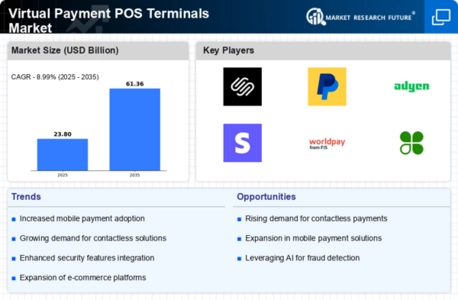Increasing Adoption of E-commerce
The rise of e-commerce has catalyzed the growth of the Virtual Payment POS Terminals Market. As more consumers opt for online shopping, businesses are compelled to adopt virtual payment solutions to facilitate seamless transactions. In 2025, it is estimated that e-commerce sales will account for a substantial percentage of total retail sales, further driving the demand for virtual payment systems. This shift not only enhances customer convenience but also allows merchants to reach a broader audience. The integration of virtual payment POS terminals enables businesses to process payments efficiently, thereby improving cash flow and customer satisfaction. Consequently, the increasing adoption of e-commerce is a pivotal driver for the Virtual Payment POS Terminals Market, as it aligns with the evolving consumer preferences for digital transactions.
Rise of Small and Medium Enterprises (SMEs)
The proliferation of small and medium enterprises (SMEs) is contributing to the expansion of the Virtual Payment POS Terminals Market. SMEs are increasingly recognizing the importance of adopting modern payment solutions to remain competitive. In 2025, it is projected that a considerable number of SMEs will implement virtual payment systems to enhance their operational capabilities. This trend is driven by the need for efficient payment processing and improved customer experiences. As SMEs seek to streamline their operations and reach a wider customer base, the demand for virtual payment POS terminals is likely to grow. The rise of SMEs represents a vital opportunity for the Virtual Payment POS Terminals Market, as these businesses look to leverage technology to drive growth.
Technological Advancements in Payment Solutions
Technological innovations are significantly influencing the Virtual Payment POS Terminals Market. The introduction of advanced payment technologies, such as mobile wallets and biometric authentication, is reshaping how transactions are conducted. In 2025, the market is expected to witness a surge in the adoption of these technologies, as they offer enhanced security and user experience. The integration of artificial intelligence and machine learning into payment systems is also anticipated to streamline operations and reduce fraud. As businesses increasingly seek to leverage these advancements, the demand for virtual payment POS terminals is likely to escalate. This trend underscores the importance of staying abreast of technological developments to remain competitive in the Virtual Payment POS Terminals Market.
Growing Consumer Preference for Digital Payments
Consumer behavior is shifting towards digital payment methods, which is a key driver for the Virtual Payment POS Terminals Market. As individuals become more accustomed to using smartphones and other digital devices for transactions, the demand for virtual payment solutions is expected to rise. In 2025, a significant percentage of consumers are projected to prefer digital payments over traditional cash transactions. This shift is influenced by the convenience, speed, and security that digital payments offer. Businesses that adapt to this changing consumer preference by implementing virtual payment POS terminals are likely to enhance their operational efficiency and customer satisfaction. Thus, the growing consumer preference for digital payments is a crucial factor propelling the Virtual Payment POS Terminals Market forward.
Regulatory Support for Digital Payment Solutions
Regulatory frameworks are increasingly supporting the adoption of digital payment solutions, which positively impacts the Virtual Payment POS Terminals Market. Governments and financial institutions are recognizing the need for secure and efficient payment systems, leading to the establishment of favorable regulations. In 2025, it is anticipated that more countries will implement policies that encourage the use of virtual payment systems, thereby fostering market growth. These regulations often focus on enhancing security measures and promoting interoperability among payment platforms. As a result, businesses are more inclined to invest in virtual payment POS terminals, knowing that they are operating within a supportive regulatory environment. This regulatory support is a significant driver for the Virtual Payment POS Terminals Market.



.webp)
.webp)
.webp)
.webp)
.webp)
.webp)








Leave a Comment